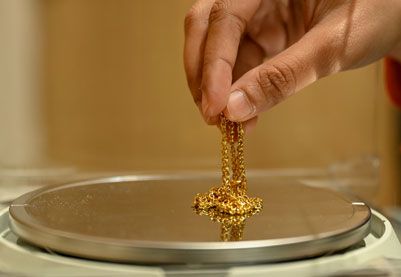Rs. 5,000 - Rs. 2 crore
To find the nearest gold loan branch,
Enter phone and OTP | Check amount you can get | Apply for quick funds
Know everything about white gold
Many people often ask, “what is white gold?” Simply put, white gold means a gold alloy mixed with white metals like palladium, nickel, or silver to give it a shiny, silvery appearance. Unlike yellow gold, white gold has a modern, elegant look, making it popular for rings, necklaces, and engagement jewellery. It is usually coated with rhodium to enhance its shine and durability. Understanding what is white gold helps you make informed choices when buying jewellery, especially if you want something stylish yet lasting. So, whether you are looking for everyday wear or a special occasion piece, knowing that white gold means a mix of gold and white metals ensures you get both beauty and strength in your jewellery.
What is the difference between white gold and yellow gold?
White gold and yellow gold mainly differ in colour and alloy composition, though both contain the same proportion of pure gold. Here’s a quick comparison:
| Feature | White gold | Yellow gold |
|---|---|---|
| Colour | Silvery-white, alloyed with metals like nickel or palladium | Warm yellow, alloyed with metals like copper |
| Gold content | Same as yellow gold (e.g., 18k = 75% gold) | Same as white gold (e.g., 18k = 75% gold) |
| Maintenance | Needs rhodium plating to retain shine | Easy care, regular cleaning and polishing |
| Durability | Slightly more scratch-resistant | Softer but hypoallergenic |
While their visual appeal and maintenance requirements differ, the choice between white and yellow gold often depends on personal preference, with both offering the same level of gold content and value, but varying in terms of appearance and long-term care needs.
Understanding white gold and its value
White gold's value is derived from its gold content and the quality of its alloy components. The price is largely influenced by the karat measurement, which indicates purity; for example, 18k white gold consists of 75% gold, while 14k contains 58.3% gold. The alloys, typically nickel, palladium, or silver, enhance the strength and durability of white gold.
Additionally, white gold is commonly coated with rhodium, providing a bright, lustrous finish and improving scratch resistance. However, this rhodium plating requires regular maintenance, as it needs reapplication to preserve its appearance.
The interplay between gold purity, alloy quality, and necessary upkeep contributes to the overall value of white gold jewellery. Its blend of elegance and durability positions white gold as a contemporary alternative to traditional yellow gold, appealing to those seeking both aesthetic appeal and practical longevity in their jewellery choices. This combination makes it a sought-after option for various types of jewellery, from engagement rings to everyday pieces.
Curious about your loan eligibility? Enter your mobile number to see how much you can get for your gold.
What is the price of white gold?
The price of white gold depends on several important factors:
- Gold market price and purity – Higher karat white gold, like 18k (75% pure gold), costs more than 14k due to its higher gold content.
- Alloy metals – Metals like palladium or nickel give white gold its silvery-white hue, slightly increasing the price.
- Rhodium plating – Adds shine and durability, contributing to the overall cost.
- Design and craftsmanship – Intricate designs, quality finishing, and the inclusion of diamonds or other precious stones can affect the price.
- Comparison with other metals – White gold is more affordable than platinum but slightly pricier than yellow gold.
Understanding these factors helps you make informed decisions when buying white gold jewellery.
Factors that affect white gold price
The price of white gold depends on several key factors:
- Gold market price and purity – Higher karat white gold, like 18k (75% pure gold), costs more than 14k due to its higher gold content.
- Alloy metals – White metals like palladium or nickel give white gold its silvery-white hue, slightly increasing the price.
- Rhodium plating – Coating adds shine and durability, contributing to the overall cost.
- Design and craftsmanship – Intricate designs, quality finishing, and inclusion of diamonds or gemstones can raise the price.
- Comparison to other metals – White gold is more affordable than platinum but pricier than yellow gold.
Considering these factors helps you make smart decisions when buying white gold jewellery.
Why is white gold gaining popularity?
White gold has been gaining popularity due to its modern aesthetic appeal and versatility. Its sleek and sophisticated appearance complements various gemstones and settings, making it a preferred choice for engagement rings, wedding bands, and other jewellery pieces. Additionally, white gold's hypoallergenic properties, compared to other metals like nickel, make it suitable for individuals with sensitive skin. As fashion trends evolve, white gold continues to remain a sought-after choice for both traditional and contemporary jewellery designs.
Advantages of white gold
White gold offers several advantages that contribute to its popularity in the jewellery industry:
- Aesthetic appeal: White gold's elegant and contemporary appearance makes it a preferred choice for modern jewellery designs. Its silvery-white hue provides a sleek and sophisticated look that complements various gemstones and settings.
- Versatility: White gold is highly versatile and can be crafted into a wide range of jewellery pieces, including engagement rings, wedding bands, necklaces, earrings, and bracelets. Its neutral colour allows it to pair seamlessly with different gemstones and metals.
- Hypoallergenic properties: Unlike some other metals like nickel, which can cause allergic reactions in sensitive individuals, white gold is often alloyed with metals like palladium or platinum, making it hypoallergenic and suitable for wearers with sensitive skin.
- Durability: White gold jewellery is durable and resistant to tarnishing, making it suitable for everyday wear. It retains its lustre and beauty over time with proper care and maintenance.
- Modern appeal: With its contemporary look and feel, white gold appeals to individuals seeking stylish jewellery options. It offers a modern alternative to traditional yellow gold while maintaining the prestige and luxury associated with gold jewellery.
- Value retention: Like yellow gold, white gold holds intrinsic value as a precious metal, making it a worthwhile investment. Its timeless appeal ensures that white gold jewellery retains its value over time, making it a valuable asset.
- Customisation: White gold can be easily customised to suit individual preferences and tastes. Whether incorporating intricate designs or personal engravings, white gold jewellery offers endless possibilities for creating unique and meaningful pieces.
These qualities make white gold a popular choice for individuals seeking stylish, durable, and timeless jewellery pieces.
It takes just 2 steps to check your eligibility for a Bajaj Finserv Gold Loan. Enter your mobile number now.
Is white gold real gold?
Yes, white gold is indeed real gold. It is a precious metal composed of gold alloyed with other white metals like nickel, palladium, or silver to achieve its distinctive colour and properties. While white gold may have a different appearance than traditional yellow gold, it maintains the intrinsic value and characteristics of gold, making it a valuable asset in the jewellery industry.
Understanding “karats”: How much pure gold is in your white gold jewellery?
The purity of white gold is measured in karats, indicating the proportion of pure gold present in the alloy. Common karatages for white gold jewellery include 14k and 18k, with 18k white gold containing a higher percentage of pure gold compared to 14k. Understanding the karatage of your white gold jewellery is crucial, as it determines its purity, durability, and value. Higher karatage white gold may be more expensive but also more malleable and luxurious, while lower karatage options offer greater durability and affordability.
Can white gold jewellery be used as collateral for a gold loan?
When considering collateral for a gold loan, white gold jewellery can indeed be a viable option. However, it's essential to understand the terms and conditions set by the lender. Some lenders may accept white gold jewellery alongside traditional yellow gold, while others may have specific criteria regarding the purity and market value of the white gold pieces. Before using white gold jewellery as collateral, it's advisable to confirm with the lender whether they accept it and what their valuation criteria are.
Before accepting gold jewellery as collateral for a loan, jewellers typically conduct several checks to assess its value and authenticity:
- Purity of gold: Jewellers often verify the purity of the gold through testing methods like acid tests or electronic testers. This determines the karatage of the gold, indicating the percentage of pure gold in the alloy.
- Weight: The weight of the gold jewellery is measured accurately, as it directly affects its value. Jewellers use precision scales to determine the weight in grams or troy ounces.
- Market value: Jewellers assess the current market value of gold to determine the loan amount they can offer against the collateral. This involves considering factors like the spot price of gold and any additional charges or premiums.
- Authenticity: To ensure the jewellery is genuine, jewellers may examine hallmarks, stamps, or other identifying marks on the pieces. This helps verify the authenticity and origin of the gold.
- Documentation: Borrowers are often required to provide relevant documentation, such as proof of ownership, identification documents, and sometimes certificates of authenticity or purchase receipts.
- Condition: The condition of the jewellery is assessed to determine its resale value. Well-maintained and intact pieces may command a higher loan amount compared to damaged or worn-out items.
- Loan terms: Jewellers explain the terms and conditions of the gold loan, including gold loan interest rates and charges and repayment terms associated with the loan.
By conducting these checks, jewellers ensure that they offer loans responsibly while safeguarding their interests and maintaining the integrity of their business operations.
Turn your gold into instant support—handle any expense with ease. Check your gold loan eligibility and access funds when you need them most.
How to calculate the price of white gold
Calculating the price of white gold involves understanding its composition and the current market price of gold. Start by identifying the karat of the white gold piece, which indicates its purity. For instance, 18k white gold contains 75% pure gold, while 14k white gold has a lower gold content.
To determine the price, first find the current market price of gold per gram. This can fluctuate based on global demand and economic conditions. Once you have this price, multiply it by the gold content of your piece. For example, if the market price is Rs. 5,000 per gram and you have an 18k white gold ring weighing 10 grams, the calculation would be:
Price of gold = Market price X Karat/24 X Weight
Example:
Price of gold = Rs. 5,000 X 18/24 X 10 = Rs. 3,750 X 10= Rs. 37,500
This formula gives you the value of the gold content in your jewellery. Keep in mind that additional factors, such as the quality of alloys used and any rhodium plating, can also influence the final price. The combined effect of these elements determines the overall valuation of the piece.
Apply in minutes. Money in account instantly with a Bajaj Finserv Gold Loan*
Related Articles
Disclaimer
Bajaj Finance Limited has the sole and absolute discretion, without assigning any reason to accept or reject any application. Terms and conditions apply*.
For customer support, call Personal Loan IVR: 7757 000 000









 Personal Loan
Personal Loan Check Eligibility
Check Eligibility Salaried Personal Loan
Salaried Personal Loan EMI Calculator
EMI Calculator Account Aggregator
Account Aggregator Credit Pulse Report
Credit Pulse Report
 Deals starting @99
Deals starting @99 Min. 50% off
Min. 50% off
 Bajaj Pay
Bajaj Pay Wallet to Bank
Wallet to Bank
 Easy EMI Loan
Easy EMI Loan Savings Offer
Savings Offer Smartphones
Smartphones Led TVs
Led TVs Washing Machines
Washing Machines Laptops
Laptops Refrigerators
Refrigerators Air Conditioner
Air Conditioner Air Coolers
Air Coolers
 Loan Against Shares
Loan Against Shares Loan Against Mutual Funds
Loan Against Mutual Funds Loan Against Insurance Policy
Loan Against Insurance Policy ESOP Financing
ESOP Financing Easy EMI Loan
Easy EMI Loan Two-wheeler Loan
Two-wheeler Loan Loan for Lawyer
Loan for Lawyer Industrial Equipment Finance
Industrial Equipment Finance Industrial Equipment Balance Transfer
Industrial Equipment Balance Transfer Industrial Equipment Refinance
Industrial Equipment Refinance Personal Loan Branch Locator
Personal Loan Branch Locator Used Tractor Loan
Used Tractor Loan Loan Against Tractor
Loan Against Tractor Tractor Loan Balance Transfer
Tractor Loan Balance Transfer Flexi
Flexi View All
View All
 Two-wheeler Loan
Two-wheeler Loan Bike
Bike Scooter
Scooter Electric Vehicle
Electric Vehicle Best Sellers
Best Sellers Popular Brands
Popular Brands

 Trading Account
Trading Account Open Demat Account
Open Demat Account Margin Trading Financing
Margin Trading Financing Share Market
Share Market Invest in IPO
Invest in IPO All stocks
All stocks Top gainers
Top gainers Top losers
Top losers 52 week high
52 week high 52 week low
52 week low Loan against shares
Loan against shares
 Home Loan
Home Loan Transfer your existing Home loan
Transfer your existing Home loan Loan against Property
Loan against Property Home Loan for Salaried
Home Loan for Salaried Home loan for self employed
Home loan for self employed Loan Against Property Balance Transfer
Loan Against Property Balance Transfer Home Loan EMI Calculator
Home Loan EMI Calculator Home Loan eligibility calculator
Home Loan eligibility calculator Home Loan balance transfer
Home Loan balance transfer View All
View All
 Term Life Insurance
Term Life Insurance ULIP Plan
ULIP Plan Savings Plan
Savings Plan Family Insurance
Family Insurance Senior Citizen Health Insurance
Senior Citizen Health Insurance Critical Illness Insurance
Critical Illness Insurance Child Health Insurance
Child Health Insurance Pregnancy and Maternity Health Insurance
Pregnancy and Maternity Health Insurance Individual Health Insurance
Individual Health Insurance Low Income Health Insurance
Low Income Health Insurance Student Health Insurance
Student Health Insurance Group Health Insurance
Group Health Insurance Retirement Plans
Retirement Plans Child Plans
Child Plans Investment Plans
Investment Plans
 Business Loan
Business Loan Secured Business Loan
Secured Business Loan Loan against property
Loan against property Loans against property balance transfer
Loans against property balance transfer Loan against shares
Loan against shares Home Loan
Home Loan Loans against mutual funds
Loans against mutual funds Loan against bonds
Loan against bonds Loan against insurance policy
Loan against insurance policy
 Apply for Gold Loan
Apply for Gold Loan Transfer your Gold Loan with Us
Transfer your Gold Loan with Us Gold Loan Branch Locator
Gold Loan Branch Locator
 ULIP Plan
ULIP Plan Savings Plan
Savings Plan Retirement Plans
Retirement Plans Child Plans
Child Plans Free Demat Account
Free Demat Account Invest in Stocks
Invest in Stocks Invest in IPO
Invest in IPO Margin Trading Facility
Margin Trading Facility Fixed Deposit Branch Locator
Fixed Deposit Branch Locator
 Check your Credit Score
Check your Credit Score
 New Car Loan
New Car Loan Used Car Loan
Used Car Loan Loan Against Car
Loan Against Car Car Loan Balance Transfer and Top-up
Car Loan Balance Transfer and Top-up My Garage
My Garage
 Get Bajaj Prime
Get Bajaj Prime
 Mobiles on EMI
Mobiles on EMI Electronics on EMI Offer
Electronics on EMI Offer  Iphone on EMI
Iphone on EMI LED TV on EMI
LED TV on EMI Refrigerator on EMI
Refrigerator on EMI Laptop on EMI
Laptop on EMI Kitchen appliances on EMI
Kitchen appliances on EMI Washing machines
Washing machines
 Personal Loan EMI Calculator
Personal Loan EMI Calculator Personal Loan Eligibility Calculator
Personal Loan Eligibility Calculator Home Loan EMI Calculator
Home Loan EMI Calculator Home Loan Eligibility Calculator
Home Loan Eligibility Calculator Good & Service Tax (GST) Calculator
Good & Service Tax (GST) Calculator Flexi Day Wise Interest Calculator
Flexi Day Wise Interest Calculator Flexi Transaction Calculator
Flexi Transaction Calculator Secured Business Loan Eligibility Calculator
Secured Business Loan Eligibility Calculator Fixed Deposits Interest Calculator
Fixed Deposits Interest Calculator Two wheeler Loan EMI Calculator
Two wheeler Loan EMI Calculator New Car Loan EMI Calculator
New Car Loan EMI Calculator Used Car Loan EMI Calculator
Used Car Loan EMI Calculator All Calculator
All Calculator Used Tractor Loan EMI Calculator
Used Tractor Loan EMI Calculator
 Hot Deals
Hot Deals Clearance Sale
Clearance Sale Kitchen Appliances
Kitchen Appliances Tyres
Tyres Camera & Accessories
Camera & Accessories Mattresses
Mattresses Furniture
Furniture Watches
Watches Music & Audio
Music & Audio Cycles
Cycles Mixer & Grinder
Mixer & Grinder Luggage & Travel
Luggage & Travel Fitness Equipment
Fitness Equipment Fans
Fans
 Personal Loan for Doctors
Personal Loan for Doctors Business loan for Doctors
Business loan for Doctors Home Loan
Home Loan Secured Business Loan
Secured Business Loan Loan against property
Loan against property Secured Business Loan Balance Transfer
Secured Business Loan Balance Transfer Loan against share
Loan against share Gold Loan
Gold Loan Medical Equipment Finance
Medical Equipment Finance
 Smart Hub
Smart Hub ITR Service
ITR Service Digi Sarkar
Digi Sarkar
 Savings Offer
Savings Offer Easy EMI
Easy EMI Offer World
Offer World 1 EMI OFF
1 EMI OFF New Launches
New Launches Zero Down Payment
Zero Down Payment Clearance Sale
Clearance Sale Bajaj Mall Sale
Bajaj Mall Sale
 Mobiles under ₹20,000
Mobiles under ₹20,000 Mobiles under ₹25,000
Mobiles under ₹25,000 Mobiles under ₹30,000
Mobiles under ₹30,000 Mobiles under ₹35,000
Mobiles under ₹35,000 Mobiles under ₹40,000
Mobiles under ₹40,000 Mobiles under ₹50,000
Mobiles under ₹50,000
 Articles
Articles
 Overdue Payments
Overdue Payments Other Payments
Other Payments
 Document Center
Document Center Bank details & Documents
Bank details & Documents Tax Invoice Certificate
Tax Invoice Certificate
 Do Not Call Service
Do Not Call Service
 Hamara Mall Orders
Hamara Mall Orders

 Fixed Deposit (IFA) Partner
Fixed Deposit (IFA) Partner Loan (DSA) Partner
Loan (DSA) Partner Debt Management Partner
Debt Management Partner EMI Network Partner
EMI Network Partner Became a Merchant
Became a Merchant Partner Sign-in
Partner Sign-in
 Trade directly with your Demat A/c
Trade directly with your Demat A/c ITR
ITR My Garage
My Garage
 Live Videos - Beta
Live Videos - Beta
 Savings Offer
Savings Offer Smartphones
Smartphones LED TVs
LED TVs Washing Machines
Washing Machines Laptops
Laptops Refrigerators
Refrigerators Air Conditioners
Air Conditioners Air Coolers
Air Coolers Water Purifiers
Water Purifiers Tablets
Tablets Kitchen Appliances
Kitchen Appliances Mattresses
Mattresses Furniture
Furniture Music and Audio
Music and Audio Cameras & Accessories
Cameras & Accessories Cycle
Cycle Watches
Watches Tyres
Tyres Luggage & Travel
Luggage & Travel Fitness Equipment
Fitness Equipment Tractor
Tractor Easy EMI Loan
Easy EMI Loan
 vivo Mobiles
vivo Mobiles OPPO Mobiles
OPPO Mobiles Xiaomi Mobiles
Xiaomi Mobiles Sony LED TVs
Sony LED TVs Samsung LED TVs
Samsung LED TVs LG LED TVs
LG LED TVs Haier LED TVs
Haier LED TVs Godrej Refrigerators
Godrej Refrigerators Voltas Washing Machines
Voltas Washing Machines
 New Tractor Loan
New Tractor Loan Used Tractor Loan
Used Tractor Loan Loan Against Tractor
Loan Against Tractor Tractor Loan Balance Transfer
Tractor Loan Balance Transfer
 New Car Loan
New Car Loan New Cars Under ₹10 Lakh
New Cars Under ₹10 Lakh New Cars – ₹10–₹15 Lakh
New Cars – ₹10–₹15 Lakh New Cars – ₹15–₹20 Lakh
New Cars – ₹15–₹20 Lakh New Cars – ₹20–₹25 Lakh
New Cars – ₹20–₹25 Lakh New Car Brands
New Car Brands Petrol – New Cars
Petrol – New Cars Diesel – New Cars
Diesel – New Cars Electric – New Cars
Electric – New Cars CNG – New Cars
CNG – New Cars Hybrid – New Cars
Hybrid – New Cars









